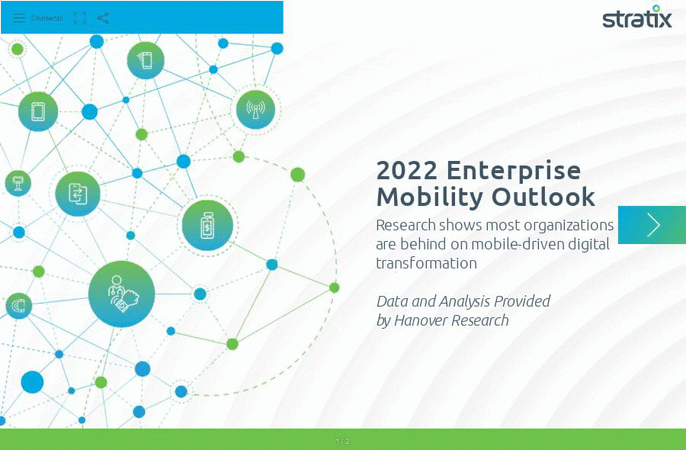Most Companies Don’t Understand How to Get the Full Value of Enterprise Mobility
Written by Elizabeth Klingseisen
2Min Read
Blog
There’s an old saying in business that “you don’t know what you don’t know,” and we found a lot of that in our new 2022 Enterprise Mobility Outlook. The report is a significant piece of research we do every year to understand what’s working and what’s not for organizations to identify trends and help our customers make better strategic decisions. New for this year is our Mobile-First Score, which measures how enterprises see themselves vs. the reality. The results show how companies are being held back by their self-perception and a lack of understanding.
What Is Mobile-First and Why Does It Matter?
Enterprises have been moving workflows to mobile devices for years, but the disruption caused by the pandemic hyper-accelerated mobile-driven digital transformation. Leaders quickly saw how mobile solutions increase automation, improve workflows, and create better experiences for both users and customers, so they’re planning more investment in mobile. In a recent report, IDC predicts that “more than 70 percent of global enterprises and 60 percent of U.S. enterprises plan to move to a wireless-first strategy for local and wide-area operations in the next two years.”
But where many organizations fall short is when they adopt mobile solutions piecemeal. Getting the total value of mobile-driven digital transformation requires the adoption of mobile-first principles that put mobile at the heart of strategy, operations, and the user experience. When you don’t, you lose many of the efficiencies, cost savings, and competitive advantages of a holistic strategy.
Perception vs. Reality
In our survey of nearly 300 enterprise leaders, we first asked them to rate their organization on how well they’ve adopted mobile-first principles. Sixty-four percent ranked themselves as either mobile-first or somewhat mobile-first. But when we calculated their responses to a battery of questions designed to determine their true status, only 29 percent got a high score, and 41 percent came in at mid-level.
Why the Dissonance?
From the research, it’s very apparent that many leaders think their organizations are mobile-first because they’re using mobile devices in a significant number of workflows, but they’re missing the holistic approach. To be truly mobile-first, mobile has to be central to strategic decision-making. They have to have a comprehensive understanding of their mobile environment, and they need to be proactive in their digital transformation from a mobile perspective.
- Centralized Decision Making: When decision-making is centralized, leaders can really leverage a holistic view of an entire organization and see where there are opportunities for scale, potential savings, huge increases in efficiency, and customer satisfaction and service. You can think about the journey for all the stakeholders and how it fits into the overall goals of the organization.
- Comprehensive Understanding: Knowing the organizations’ mobile environment means that leaders can proactively manage it. They can track device inventories and statuses. They can forecast future needs. They can see potential security vulnerabilities and defend against them more efficiently.
- Proactive Digital Transformation: Mobile-first principles lead to more efficient change management processes that generate a higher ROI when organizations proactively engage in thoughtful examinations of workflows and look for opportunities to improve comprehensively across the entire organization.
It’s More Than Self-Perception
While Organizations may not fully understand what it is to be mobile-first, the 2022 Enterprise Mobility Outlook also found they can’t step back to look at the big picture because they’re struggling with the day-to-day.
Leaders told us that their teams spent significant amounts of time each week on mobile technology management. Thirty percent said security is a constant concern. Twenty percent spend all week on end-user support, with the vast majority devoting more than three hours a week. If you couple that with the fact that 83 percent reported some degree of difficulty finding qualified IT staff, the struggle is real with mobile.
We understand that at Stratix and can provide the resources enterprises need to achieve mobile-first status. If you have questions, please reach out.

2022 ENTERPRISE MOBILITY OUTLOOK
Research shows most organizations are behind on mobile-driven digital transformation.
Read Report













